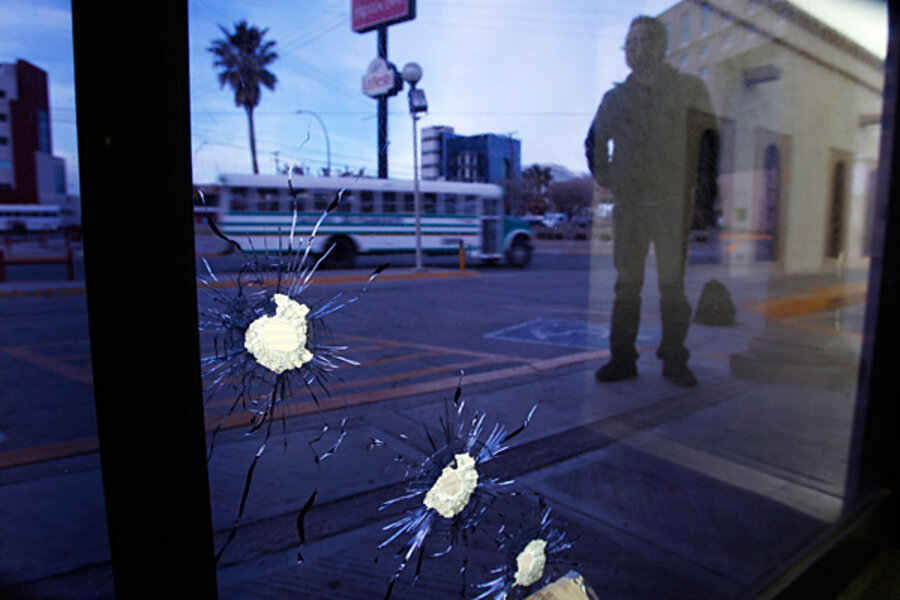Study: A quarter million US guns are smuggled into Mexico every year
Loading...
| Mexico City
Some 2.2 percent of all US gun sales are made to smuggling rings that take firearms to Mexico, a scale of illegal trafficking that’s “much higher than widely assumed,” an academic study released Monday found.
An average of 253,000 weapons purchased in the United States head south of the border each year, according to the study by four scholars at the University of San Diego’s Trans-Border Institute and the Igarape Institute, a research center in Rio de Janeiro, Brazil.
Profit margins at many gun stores are razor thin, and thousands of US gun vendors would go out of business without the illicit traffic to Mexico, said Topher McDougal, an economist educated at the Massachusetts Institute of Technology who’s one of the study’s authors.
The study’s conclusions are likely to add to controversy over what role US weapons smugglers play in Mexico’s drug violence. Mexican officials have long blamed lax gun laws in the United States for the availability of weapons in Mexico, which has only one gun store and considers gun ownership a privilege, not a right.
The value of the annual smuggling trade is $127.2 million, says the study, “The Way of the Gun: Estimating Firearms Traffic Across the U.S.-Mexico Border.”
The traffic is reflected in the disproportionately high number of federally licensed firearms dealers along the US side of the border, said Robert Muggah, another of the four scholars. Of the 51,300 retail gun shops in the United States that hold federal licenses, some 6,700 of them are concentrated in the four US states that border Mexico, Muggah said. On average, there are more than three gun dealers for every mile of the 1,970-mile border between the countries.
“The Mexican demand explains that abundance and the successful nature of the business,” Muggah said.
Another key indicator of the US influence over gun availability in Mexico is the fact that many killings in Mexico are carried out with handguns, not the high-powered assault weapons that garner much of the attention related to the country’s violence.
“The vast majority of deaths arising from violence in Mexico are from .38s or that caliber of handgun,” Muggah said. “It just so happens that the largest market for .38 Specials is the United States.”
The scholars said their study was the first “empirically robust” effort to “estimate the total flow of arms” heading south from the United States. The authors said they’d determined the likely traffic to Mexico by a complex statistical formula that measured how close a federally licensed dealer was to the Mexican border, then factored out likely local legal demand, based on population and income.
“These findings suggest that the United States is a significant, albeit unintentional, contributor to the global black market in arms and ammunition (and specifically in Mexico),” the study says.
Some 2,200 US manufacturers of firearms, ammunition and parts produce a total of 4.2 million firearms a year, the study says. One in every four US citizens owns a firearm, it adds.
Mexico’s sole gun store, operated by the Defense Secretariat in Mexico City, sells largely .38-caliber or smaller firearms and only to those who obtain licenses first.
Even so, members of organized crime have amassed a growing arsenal of outlawed weapons, including 9 mm pistols, .38-caliber “super” pistols, .45-caliber pistols, AR-15 and AK-47-type assault rifles, grenades, and rocket-propelled grenade launchers, the study notes.
Mexican police and soldiers have seized some 140,000 weapons since 2006, when former President Felipe Calderon deployed soldiers and federal police units to contain violence between crime groups and to hunt drug lords.
A soaring homicide rate cast a cloud over much of his six-year term. Some 120,000 homicides occurred while he was in office, and at least 60,000 of them appeared to involve criminal gangs, the study says.
Not all weapons in Mexico come from the United States, the study says, noting that “alternative sources” are suggested by the discovery of a “a wide variety of non-U.S. weaponry ... including Soviet-era RPG-7s, Korean fragmentation grenades, M60 machine guns, Chinese TK-56s and others.”
The authors said a series of factors – such as sales from gun shows and private dealers – made their estimates, if anything, low.
Gunrunning from the United States was at the heart of a scandal that enveloped the Bureau of Alcohol, Tobacco, Firearms and Explosives, a division of the Justice Department, in 2011. In Operation Fast and Furious, ATF agents allowed “straw buyers” to purchase some 2,000 firearms. The agents’ intent was to track the guns to Mexican cartel chiefs.
But the agents lost track of some of the guns, which subsequently were used in scores of crimes that led to death or serious wounds for at least 150 Mexicans and one US Border Patrol agent. Last June, the House of Representatives voted to hold Attorney General Eric Holder in criminal contempt for refusing to turn over documents related to the botched gunrunning sting.
The number of weapons involved in Fast and Furious, however, would be less than 1 percent of the number of weapons that are reaching Mexico illegally each year, if the study is accurate.
In concluding recommendations, the study suggests that purchasers of firearms in border states be barred from paying cash for the weapons. Requiring the use of checks or credit cards would “help to ensure that funds used to buy guns at legitimate establishments will not originate from illicit business activities,” it says.
The study urges more sophisticated US background checks of buyers to help identify “straw purchasers” and the development of a database of seized guns in Mexico. It suggests that US authorities gather more data on sales tax revenue from gun stores by county “to identify unusual activity that should be investigated.”
Read more here: http://www.mcclatchydc.com/2013/03/18/186216/253000-us-guns-smuggled-to-mexico.html?utm_source=twitterfeed&utm_medium=twitter#storylink=cpy





